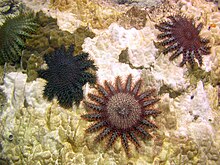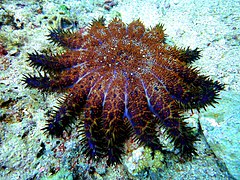
The crown-of-thorns starfish, Acanthaster planci, is a large starfish that preys upon hard, or stony, coral polyps (Scleractinia). The crown-of-thorns starfish receives its name from venomous thorn-like spines that cover its upper surface, resembling the biblical crown of thorns. It is one of the largest starfish in the world.
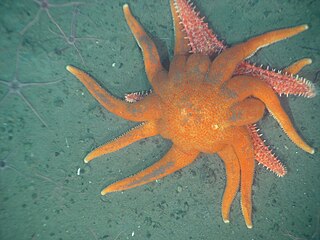
The Valvatida are an order of starfish in the class Asteroidea, which contains 695 species in 172 genera in 17 families.
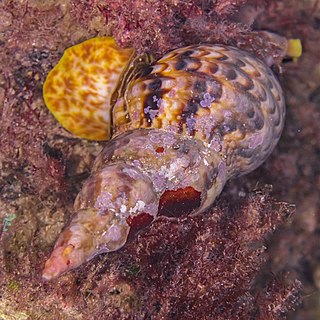
Charonia tritonis, common name the Triton's trumpet, the giant triton or pū is a species of very large sea snail, a marine gastropod mollusc in the family Charoniidae, the tritons. Reaching up to two feet in shell length this is one of the biggest mollusks in the coral reef.

Acanthaster brevispinus, the short-spined crown-of-thorns starfish, is one of the two members of the starfish genus Acanthaster, along with the much better-known A. planci, the common crown-of-thorns starfish.
Chantal Conand is a French marine biologist and oceanographer.

Acropora abrotanoides is a species of acroporid coral found in Indo-Pacific waters from the Red Sea and the Gulf of Aden east to the East China Sea, Japan, the central Pacific Ocean and Australia. It is found in shallow coral reefs that are exposed to the action of strong waves, at depths up to 15 m. It is vulnerable to coral bleaching, disease and crown-of-thorns starfish. It is resistant to predation as it has well-developed radial corallite lips.
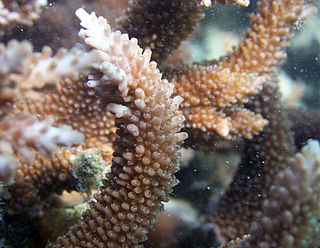
Acropora acuminata is a species of acroporid coral found in Australia, the Red Sea, the central Indo-Pacific, Japan, the northern Indian Ocean, the East China Sea, southeast Asia, and the western Pacific Ocean. It is particularly susceptible to coral bleaching, the crown-of-thorns sea star, and harvesting for the aquarium trade. It is found on shallow coral reefs from depths of 5–20 m. It was described by Verrill in 1864.
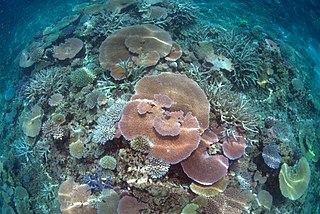
Acropora hyacinthus is a species of Acropora described from a specimen collected in Fiji by James Dwight Dana in 1846. It is thought to have a range that includes the Indian Ocean, the Indo-Pacific waters, southeast Asia, Japan, the East China Sea and the western Pacific Ocean. It lives on shallow reefs on upper reef slopes, and is found from depths of 1–25 metres (3.3–82.0 ft). Crown-of-thorns starfish preferentially prey upon Acropora corals.

Acropora cerealis is a species of acroporid coral found throughout the Indian and Pacific oceans, from the Red Sea and the Gulf of Aden to the Hawaiian Islands and the Johnston Atoll. It can be found on upper reef slopes in shallow tropical reefs, from depths of 3–20 m. Crown-of-thorns starfish preferentially prey upon Acropora corals, and this species is also harvested for the aquarium trade.

Acropora muricata, commonly called staghorn coral, is a species of acroporid coral found in the Gulf of Aden, the Red Sea, Indian Ocean, Persian Gulf, Australia, central Indo-Pacific, Japan, Southeast Asia, the East China Sea and the oceanic central and western Pacific Ocean. It is found in tropical shallow reefs, slopes of reefs, and in lagoons, from depths of 5 to 30 m. It was described by Dana in 1846.

Acropora listeri is a species of acroporid coral found in the Gulf of Aden, the Red Sea, the northern Indian Ocean, Australia, the central Indo-Pacific, Japan, southeast Asia, the East China Sea and the central and western Pacific Ocean. It is also present in Mauritius. The species is found in tropical shallow reefs on their upper slopes, especially in locations exposed to the action of strong waves, at depths of between 3 and 15 metres. It was described by Brook in 1893.

Acropora lutkeni is a species of acroporid coral found in the central Indo-Pacific, Japan, Australia, the northern Indian Ocean, the East China Sea, southeast Asia, and the central and western Pacific Ocean. The species also occurs in the south Mariana Islands, American Samoa, Palau, the Andaman Islands, Fiji, the Philippines, the Banggai Islands, Samoa, the Raja Ampat Islands, the Line Islands, Papua New Guinea, and the Chagos Archipelago. It exists in tropical shallow reefs on upper slopes that are exposed to the action of strong waves or currents, and subtidally on edges of reefs and in submerged reefs. It exists at depths of between 3 and 12 metres and probably spawns in October.
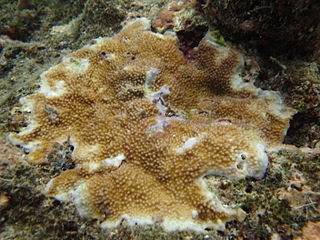
Acropora palmerae is a species of acroporid coral found in the northern Indian Ocean, the central Indo-Pacific, Australia, Southeast Asia, Japan, the East China Sea and the oceanic west Pacific Ocean. It is also found in Palau and the Mariana Islands, American Samoa, the Andaman Islands, the Great Barrier Reef, Okinawa Island, Mauritius, Micronesia, the Cook Islands and the Philippines. It occurs in tropical shallow reefs on flats exposed the action of strong waves and in lagoons, from depths of 0 to 12 metres. It was described by Wells in 1954.
Acropora speciosa is a species of acroporid coral found in the Red Sea, the Gulf of Aden, the southwest and northern Indian Ocean, the central Indo-Pacific, Southeast Asia, Japan, the East China Sea, eastern Australia and the oceanic west and central Pacific Ocean. It occurs in shallow reefs at depths of 2 to 25 metres.
Acropora subglabra is a species of acroporid coral found in the northern Indian Ocean, the central Indo-Pacific, Australia, Southeast Asia, Japan, the East China Sea and the oceanic west Pacific Ocean. It occurs in tropical shallow reefs, and its range is often restricted to sheltered back reefs containing soft substrates and clear water. It can be found from depths of 5 to 15 metres and was described by Brook in 1891.
Acropora teres is a species of acroporid coral found in the central Indo-Pacific, Southeast Asia, Japan, the East China Sea and the oceanic western Pacific Ocean. It is found in tropical shallow reefs on slopes and in lagoons, at depths of between 2 and 20 metres. The taxonomic status of this species is uncertain. It was described as Madrepora teres by Verrill in 1866.

Acropora valida is a species of acroporid coral found in the Red Sea, the Gulf of Aden, the southwestern, northwestern and northern Indian Ocean, the Persian Gulf, the central Indo-Pacific, Australia, southeast Asia, Japan, the East China Sea, the oceanic western, central and far eastern Pacific Ocean, the northwestern Hawaiian Islands and Johnston Atoll. It occurs in tropical shallow reefs in a variety of reef habitats, at depths of 1 to 15 metres.

Acropora vaughani is a species of acroporid coral found in the northern Indian Ocean, the central Indo-Pacific, Australia, southeast Asia, Japan, the East China Sea and the oceanic western and central Pacific Ocean. It is also found in Madagascar. It occurs in tropical shallow reefs around fringing reefs in turbid water, at depths of between 3 and 20 metres. It was described by J. W. Wells in 1954.

Acropora humilis, also known as finger coral, is a species of acroporid coral found in the Gulf of Aden, the Red Sea, the northern and southwestern Indian Ocean, Australia, the central Indo-Pacific, Japan, southeast Asia, the East China Sea, the central and western Pacific Ocean, the Johnston Atoll and the northwestern Hawaiian Islands. It also occurs in the Raja Ampat Islands, Mariana Islands, Palau, and the Pitcairn Islands. Occurring in tropical shallow reefs on upper reef flats and slopes at depths of up to 12 metres (39 ft), it was described by Dana in 1846.
Paracorynactis is a genus of corallimorphs from the western Indo-West Pacific. They are specialized predators of echinoderms, and are notable for preying on the destructive crown-of-thorns starfish among others. The genus is monotypic with the single species, Paracorynactis hoplites.
